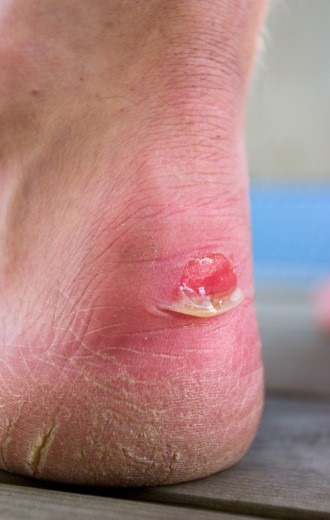 Also known as vesicles, blisters form when “the top layer of skin pulls away from lower layers and then fills with fluid.” Constant pressure and friction can lead to your skin breaking and blisters forming. Blisters are your body’s response to protecting and healing your skin, so avoid draining a blister if it is recently formed, as this can lead to infection. Different factors can affect why blisters form, including ill-fitting shoes that rub on your feet, or socks that retain sweat and moisture.
Also known as vesicles, blisters form when “the top layer of skin pulls away from lower layers and then fills with fluid.” Constant pressure and friction can lead to your skin breaking and blisters forming. Blisters are your body’s response to protecting and healing your skin, so avoid draining a blister if it is recently formed, as this can lead to infection. Different factors can affect why blisters form, including ill-fitting shoes that rub on your feet, or socks that retain sweat and moisture.
Blisters are prone to making everyday activities extremely uncomfortable. If your feet are hurting, visit one of our podiatrists of The Podiatry Center, P.C.. Our doctors will assess your injury and provide you with quality treatment.
Foot Blisters
Foot blisters develop as a result of constantly wearing tight or ill-fitting footwear. This happens due to the constant rubbing from the shoe, which can often lead to pain.
What are Foot Blisters?
A foot blister is a small fluid-filled pocket that forms on the upper-most layer of the skin. Blisters are filled with clear fluid and can lead to blood drainage or pus if the area becomes infected.
How do Blisters Form?
Blisters on the feet are often the result of constant friction of skin and material, usually by shoe rubbing. Walking in sandals, boots, or shoes that don’t fit properly for long periods of time can result in a blister. Having consistent foot moisture and humidity can easily lead to blister formation.
Prevention & Treatment
It is important to properly care for the affected area in order to prevent infection and ease the pain. Do not lance the blister and use a Band-Aid to provide pain relief. Also, be sure to keep your feet dry and wear proper fitting shoes. If you see blood or pus in a blister, seek assistance from a podiatrist.
If you have any questions, please feel free to contact our office located in Millburn, NJ. We offer the newest diagnostic tools and technologies to treat your foot and ankle needs.
